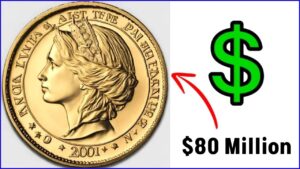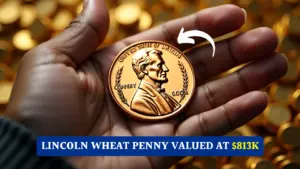Imagine finding a small, seemingly ordinary coin in your pocket change, only to discover that it’s worth a staggering $141,000. For numismatics enthusiasts and casual collectors alike, the Lincoln Wheat Penny represents an exciting prospect that transcends its original function as a humble coin. But what makes this penny so special, how did it come to exist, and is it really still out there waiting to be found? In this post, we’ll delve into the intriguing world of the Lincoln Wheat Penny, uncovering its history, unique value, and why it remains a cherished symbol of rarity.
A Brief History of the Lincoln Wheat Penny
The Lincoln Wheat Penny, also referred to as the “Wheat Cent,” was first introduced in 1909 to mark the centennial of President Abraham Lincoln’s birth. Its design was a significant departure from previous coins, featuring the image of Lincoln on its obverse side a decision that made it the first U.S. coin to prominently display the likeness of an actual historical figure.
This design choice was spearheaded by President Theodore Roosevelt, who sought to modernize U.S. coinage and honor Lincoln’s enduring legacy. The coin’s designer, Victor David Brenner, meticulously crafted Lincoln’s profile based on a photograph taken by Mathew Brady. The reverse side, featuring two wheat stalks, symbolized growth and prosperity, elements closely tied to the American ethos during that era.
Produced until 1958, the Lincoln Wheat Penny remains a symbol of history, artistry, and economic resilience, often found in collections around the world.
Why Is the Lincoln Wheat Penny So Valuable?
While most Lincoln Wheat Pennies have minimal monetary worth beyond their face value, certain rare variants have achieved legendary status due to their scarcity and historical significance. One such variant is the 1943 copper penny, a coin minted in a year when all pennies were supposed to be made of steel to save copper for the war effort during World War II.
It is believed that a small batch of copper planchets were left behind in the minting machines, resulting in the accidental production of copper pennies. These pennies are incredibly rare, with only a few known examples in existence, making them one of the holy grails of coin collecting.
What’s remarkable is that the last recorded sale of a 1943 copper penny fetched a jaw-dropping $141,000 a testament to its rarity and the intense demand among collectors. Other notable Lincoln Wheat Pennies, such as the 1909 “S VDB” (featuring Brenner’s initials) or the 1955 double-die obverse variant, also command high premiums due to their unique characteristics.
Identifying a Rare Lincoln Wheat Penny
Finding a rare Lincoln Wheat Penny could be an exciting experience, but you’ll need to know what to look for. Here are some essential tips to help you identify one:
1. Check the Year
Certain years are associated with high-value Wheat Pennies. The 1943 copper penny is the most famous example, but other valuable years include 1909, especially those minted with the “S VDB” marking, and the 1955 double-die obverse variant.
2. Examine the Material
Most 1943 Lincoln pennies were made of steel coated with zinc. If you happen to come across a 1943 penny that looks coppery, you may have found a rare treasure.
3. Look for Mint Marks
Mint marks can add to a penny’s value. For instance, coins marked with an “S” (San Francisco) or “D” (Denver) may have increased rarity depending on the year.
4. Assess Condition
Coins in pristine or near-mint condition tend to fetch higher prices. Toning, wear, and scratches can significantly reduce their value.
5. Search for Errors
Minting errors are another factor that can make a Lincoln Wheat Penny exceptionally valuable. Examples include double stamping, missing letters, or off-center strikes.
Where to Search for Lincoln Wheat Pennies
Although rare Lincoln Wheat Pennies are, well, rare, you never know where you might come across one. Here are some places to look:
- Loose Change: Always inspect your pocket change rare finds could be hiding in plain sight.
- Piggy Banks and Coin Jars: Forgotten coin collections might contain valuable treasures.
- Antique Shops and Estate Sales: These venues often have assortments of old coins, including pennies.
- Inherited Collections: Coins passed down through generations might include rare Lincoln Wheat Pennies.
- Coin Shows and Auctions: Professional collectors and dealers often showcase valuable coins at such events.
What to Do If You Find a Rare Penny
If you think you’ve discovered a rare Lincoln Wheat Penny, here’s how to proceed:
- Preserve the Coin: Do not attempt to clean or polish the coin, as this can reduce its value. Handle it carefully to avoid damage.
- Verify Authenticity: Have the penny authenticated by a reputable coin dealer or numismatist.
- Research Its Value: Use online resources, auction records, and collector guides to estimate the potential worth of your penny.
- Consider Selling: If you’re looking to capitalize on your find, consult professional auction houses or collectors to determine the best way to sell.
The Enduring Legacy of the Lincoln Wheat Penny
Beyond its monetary value, the Lincoln Wheat Penny serves as a tangible connection to the past a relic of American history, ingenuity, and the challenges of wartime economy. Its design celebrates one of the nation’s most revered leaders, while its rarity adds an element of intrigue and excitement for collectors.
For those who appreciate numismatics, the Lincoln Wheat Penny is more than just a coin; it’s a piece of art and a historical artifact. Whether you’re a seasoned collector or simply curious about coins, the Wheat Penny invites us all to take a closer look at the small, overlooked treasures in our lives.
Final Thoughts
The next time you’re sorting through your change, take an extra moment to inspect each coin. While the odds of finding a rare Lincoln Wheat Penny are slim, the thrill of the hunt and the chance to unearth a piece of history make it worthwhile. Perhaps you’ll be the lucky one to discover a $141K treasure hiding in your pocket or maybe you’ll simply gain a newfound appreciation for the stories coins can tell.
Happy coin hunting, and may your search uncover treasures both valuable and meaningful.
FAQs
- Why is the 1943 Lincoln Wheat Penny so valuable?
Because it was mistakenly minted in copper during a year when pennies were supposed to be made of steel for the war effort. - What makes a Lincoln Wheat Penny rare?
Rarity can be due to minting errors, limited editions, unusual materials, or specific years like 1909-S VDB or 1955 double-die. - How can I tell if I have a valuable Wheat Penny?
Check the year, material, mint mark, and condition—rare traits often appear in coins with unique features or errors. - Where can I search for rare Lincoln Wheat Pennies?
Check your pocket change, piggy banks, old coin jars, estate sales, and inherited collections. - What should I do if I find a potentially rare penny?
Avoid cleaning it, handle it carefully, get it authenticated, research its value, and consult experts before selling.


